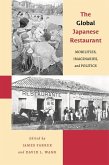- Gebundenes Buch
- Merkliste
- Auf die Merkliste
- Bewerten Bewerten
- Teilen
- Produkt teilen
- Produkterinnerung
- Produkterinnerung
After war defeat in 1945, Japan underwent historic political, economic and social transformations resulting in the country's rebirth as an economic powerhouse and exemplar of liberal democracy in East Asia. This handbook expands and enriches our understanding of this tumultuous contemporary era in Japan's modern history.
Andere Kunden interessierten sich auch für
![Handbook of Japanese Christian Writers Handbook of Japanese Christian Writers]() Mark WilliamsHandbook of Japanese Christian Writers218,99 €
Mark WilliamsHandbook of Japanese Christian Writers218,99 €![The Global Japanese Restaurant The Global Japanese Restaurant]() James FarrerThe Global Japanese Restaurant75,99 €
James FarrerThe Global Japanese Restaurant75,99 €![Handbook of Modern and Contemporary Japanese Women Writers Handbook of Modern and Contemporary Japanese Women Writers]() To Mhm LimitedHandbook of Modern and Contemporary Japanese Women Writers216,99 €
To Mhm LimitedHandbook of Modern and Contemporary Japanese Women Writers216,99 €![Being Korean, Becoming Japanese? Being Korean, Becoming Japanese?]() Hwaji ShinBeing Korean, Becoming Japanese?68,99 €
Hwaji ShinBeing Korean, Becoming Japanese?68,99 €![Japan's Private Spheres: Autonomy in Japanese History, 1600-1930 Japan's Private Spheres: Autonomy in Japanese History, 1600-1930]() William Puck BrecherJapan's Private Spheres: Autonomy in Japanese History, 1600-1930155,99 €
William Puck BrecherJapan's Private Spheres: Autonomy in Japanese History, 1600-1930155,99 €![The Japanese Ethos The Japanese Ethos]() Yasuoka MasahiroThe Japanese Ethos24,99 €
Yasuoka MasahiroThe Japanese Ethos24,99 €![Japanese Through American Eyes Japanese Through American Eyes]() Sheila K JohnsonJapanese Through American Eyes108,99 €
Sheila K JohnsonJapanese Through American Eyes108,99 €-
-
-
After war defeat in 1945, Japan underwent historic political, economic and social transformations resulting in the country's rebirth as an economic powerhouse and exemplar of liberal democracy in East Asia. This handbook expands and enriches our understanding of this tumultuous contemporary era in Japan's modern history.
Produktdetails
- Produktdetails
- Verlag: Routledge
- Seitenzahl: 406
- Erscheinungstermin: 15. Juli 2023
- Englisch
- Abmessung: 250mm x 175mm x 26mm
- Gewicht: 877g
- ISBN-13: 9789048559374
- ISBN-10: 9048559375
- Artikelnr.: 69906748
- Herstellerkennzeichnung
- Libri GmbH
- Europaallee 1
- 36244 Bad Hersfeld
- gpsr@libri.de
- Verlag: Routledge
- Seitenzahl: 406
- Erscheinungstermin: 15. Juli 2023
- Englisch
- Abmessung: 250mm x 175mm x 26mm
- Gewicht: 877g
- ISBN-13: 9789048559374
- ISBN-10: 9048559375
- Artikelnr.: 69906748
- Herstellerkennzeichnung
- Libri GmbH
- Europaallee 1
- 36244 Bad Hersfeld
- gpsr@libri.de
Simon Avenell is Professor of modern Japanese history at the Australian National University. He focuses on social, political, and intellectual developments after 1945. His books include Making Japanese Citizens (University of California Press, 2010), Transnational Japan in the Global Environmental Movement(University of Hawai'i Press, 2017), and Asia and Postwar Japan(Harvard University Press, 2022). In 2025 he will publish A History of Postwar Japan: Recovery, Prosperity, and Transformation (University of Hawai'i Press). He is currently conducting research on generational politics in contemporary Japan.
Introduction: Imagining Japan's Postwar Era (Simon Avenell);
Part 1: The Origins of the Postwar.
Ch. 1 Rethinking Imperial Legacies and the Cold War in Allied Occupied Japan (Deokhyo Choi);
Ch. 2 Money
Banking
and Fiscal Reforms in Allied Occupied Japan
1945-1952 (Simon James Bytheway);
Part 2: The Political Postwar.
Ch. 3 Arguing with Public Opinion: Polls and Postwar Democracy (Adam Bronson);
Ch. 4 Japanese Postwar Political History from Left to Right (James Babb);
Ch. 5 Nationalism under the Banner of Pacifism: Japanese Atomic Bombing Sufferers' Struggle against the State (Akiko Naono);
Ch. 6 Living with and Fighting against the Postwar Regime: Conservatism and Constitution in Postwar Japan (Christian G. Winkler);
Part 3: Postwar Culture and Society. Ch. 7 Gendering Postwar Japan (Emily Chapman and Helen Macnaughtan);
Ch. 8 Uncertain Futures
Destabilized Dreams (Eiko Maruko Siniawer);
Ch. 9 Education in Japan Since 1945: Equality
Hierarchy
and Competition (Peter Cave);
Ch. 10 From Raincoats to Ketchup: The Encroachment of Plastics during the High-growth Era (1955-1973) (Katarzyna J. Cwiertka);
Ch. 11 Birds and Children as Barometers of Japan's Postwar Environmental History (Janet Borland);
Ch. 12 Japan's Got Talent: The Rise of Tarento in Japanese Television Culture (Seong Un Kim);
Part 4: The Transnational Postwar.
Ch. 13 Postwar Japanese Feminism in Transnational Perspective (Julia C. Bullock);
Ch. 14 Postwar Japanese History Seen through the Science of Reproductive and Population Politics (Aya Homei);
Part 5: Japan's Postwar in Asia and the World.
Ch. 15 Japan's American Alliance: Forgoing Autonomy for Deterrence (H.D.P. Envall);
Ch. 16 The Endless Postwar: Okinawa at the Modern Frontier (Luke Franks);
Ch. 17 International Orders
Territorial Problems and Japan's Identity (Kimie Hara);
Ch. 18 Manga
National Identity and Internationalization in Postwar Japan (Rebecca Suter);
Part 6: Defining
Delineating
Historicizing
and Chronologizing the Postwar Era.
Ch. 19 Discourses of War and Peace during Japan's Postwar (Philip Seaton);
Ch. 20 Postwar in the Post-Cold War: Postwar in the Heisei Era (Eiji Oguma).
Part 1: The Origins of the Postwar.
Ch. 1 Rethinking Imperial Legacies and the Cold War in Allied Occupied Japan (Deokhyo Choi);
Ch. 2 Money
Banking
and Fiscal Reforms in Allied Occupied Japan
1945-1952 (Simon James Bytheway);
Part 2: The Political Postwar.
Ch. 3 Arguing with Public Opinion: Polls and Postwar Democracy (Adam Bronson);
Ch. 4 Japanese Postwar Political History from Left to Right (James Babb);
Ch. 5 Nationalism under the Banner of Pacifism: Japanese Atomic Bombing Sufferers' Struggle against the State (Akiko Naono);
Ch. 6 Living with and Fighting against the Postwar Regime: Conservatism and Constitution in Postwar Japan (Christian G. Winkler);
Part 3: Postwar Culture and Society. Ch. 7 Gendering Postwar Japan (Emily Chapman and Helen Macnaughtan);
Ch. 8 Uncertain Futures
Destabilized Dreams (Eiko Maruko Siniawer);
Ch. 9 Education in Japan Since 1945: Equality
Hierarchy
and Competition (Peter Cave);
Ch. 10 From Raincoats to Ketchup: The Encroachment of Plastics during the High-growth Era (1955-1973) (Katarzyna J. Cwiertka);
Ch. 11 Birds and Children as Barometers of Japan's Postwar Environmental History (Janet Borland);
Ch. 12 Japan's Got Talent: The Rise of Tarento in Japanese Television Culture (Seong Un Kim);
Part 4: The Transnational Postwar.
Ch. 13 Postwar Japanese Feminism in Transnational Perspective (Julia C. Bullock);
Ch. 14 Postwar Japanese History Seen through the Science of Reproductive and Population Politics (Aya Homei);
Part 5: Japan's Postwar in Asia and the World.
Ch. 15 Japan's American Alliance: Forgoing Autonomy for Deterrence (H.D.P. Envall);
Ch. 16 The Endless Postwar: Okinawa at the Modern Frontier (Luke Franks);
Ch. 17 International Orders
Territorial Problems and Japan's Identity (Kimie Hara);
Ch. 18 Manga
National Identity and Internationalization in Postwar Japan (Rebecca Suter);
Part 6: Defining
Delineating
Historicizing
and Chronologizing the Postwar Era.
Ch. 19 Discourses of War and Peace during Japan's Postwar (Philip Seaton);
Ch. 20 Postwar in the Post-Cold War: Postwar in the Heisei Era (Eiji Oguma).
Introduction: Imagining Japan's Postwar Era (Simon Avenell);
Part 1: The Origins of the Postwar.
Ch. 1 Rethinking Imperial Legacies and the Cold War in Allied Occupied Japan (Deokhyo Choi);
Ch. 2 Money
Banking
and Fiscal Reforms in Allied Occupied Japan
1945-1952 (Simon James Bytheway);
Part 2: The Political Postwar.
Ch. 3 Arguing with Public Opinion: Polls and Postwar Democracy (Adam Bronson);
Ch. 4 Japanese Postwar Political History from Left to Right (James Babb);
Ch. 5 Nationalism under the Banner of Pacifism: Japanese Atomic Bombing Sufferers' Struggle against the State (Akiko Naono);
Ch. 6 Living with and Fighting against the Postwar Regime: Conservatism and Constitution in Postwar Japan (Christian G. Winkler);
Part 3: Postwar Culture and Society. Ch. 7 Gendering Postwar Japan (Emily Chapman and Helen Macnaughtan);
Ch. 8 Uncertain Futures
Destabilized Dreams (Eiko Maruko Siniawer);
Ch. 9 Education in Japan Since 1945: Equality
Hierarchy
and Competition (Peter Cave);
Ch. 10 From Raincoats to Ketchup: The Encroachment of Plastics during the High-growth Era (1955-1973) (Katarzyna J. Cwiertka);
Ch. 11 Birds and Children as Barometers of Japan's Postwar Environmental History (Janet Borland);
Ch. 12 Japan's Got Talent: The Rise of Tarento in Japanese Television Culture (Seong Un Kim);
Part 4: The Transnational Postwar.
Ch. 13 Postwar Japanese Feminism in Transnational Perspective (Julia C. Bullock);
Ch. 14 Postwar Japanese History Seen through the Science of Reproductive and Population Politics (Aya Homei);
Part 5: Japan's Postwar in Asia and the World.
Ch. 15 Japan's American Alliance: Forgoing Autonomy for Deterrence (H.D.P. Envall);
Ch. 16 The Endless Postwar: Okinawa at the Modern Frontier (Luke Franks);
Ch. 17 International Orders
Territorial Problems and Japan's Identity (Kimie Hara);
Ch. 18 Manga
National Identity and Internationalization in Postwar Japan (Rebecca Suter);
Part 6: Defining
Delineating
Historicizing
and Chronologizing the Postwar Era.
Ch. 19 Discourses of War and Peace during Japan's Postwar (Philip Seaton);
Ch. 20 Postwar in the Post-Cold War: Postwar in the Heisei Era (Eiji Oguma).
Part 1: The Origins of the Postwar.
Ch. 1 Rethinking Imperial Legacies and the Cold War in Allied Occupied Japan (Deokhyo Choi);
Ch. 2 Money
Banking
and Fiscal Reforms in Allied Occupied Japan
1945-1952 (Simon James Bytheway);
Part 2: The Political Postwar.
Ch. 3 Arguing with Public Opinion: Polls and Postwar Democracy (Adam Bronson);
Ch. 4 Japanese Postwar Political History from Left to Right (James Babb);
Ch. 5 Nationalism under the Banner of Pacifism: Japanese Atomic Bombing Sufferers' Struggle against the State (Akiko Naono);
Ch. 6 Living with and Fighting against the Postwar Regime: Conservatism and Constitution in Postwar Japan (Christian G. Winkler);
Part 3: Postwar Culture and Society. Ch. 7 Gendering Postwar Japan (Emily Chapman and Helen Macnaughtan);
Ch. 8 Uncertain Futures
Destabilized Dreams (Eiko Maruko Siniawer);
Ch. 9 Education in Japan Since 1945: Equality
Hierarchy
and Competition (Peter Cave);
Ch. 10 From Raincoats to Ketchup: The Encroachment of Plastics during the High-growth Era (1955-1973) (Katarzyna J. Cwiertka);
Ch. 11 Birds and Children as Barometers of Japan's Postwar Environmental History (Janet Borland);
Ch. 12 Japan's Got Talent: The Rise of Tarento in Japanese Television Culture (Seong Un Kim);
Part 4: The Transnational Postwar.
Ch. 13 Postwar Japanese Feminism in Transnational Perspective (Julia C. Bullock);
Ch. 14 Postwar Japanese History Seen through the Science of Reproductive and Population Politics (Aya Homei);
Part 5: Japan's Postwar in Asia and the World.
Ch. 15 Japan's American Alliance: Forgoing Autonomy for Deterrence (H.D.P. Envall);
Ch. 16 The Endless Postwar: Okinawa at the Modern Frontier (Luke Franks);
Ch. 17 International Orders
Territorial Problems and Japan's Identity (Kimie Hara);
Ch. 18 Manga
National Identity and Internationalization in Postwar Japan (Rebecca Suter);
Part 6: Defining
Delineating
Historicizing
and Chronologizing the Postwar Era.
Ch. 19 Discourses of War and Peace during Japan's Postwar (Philip Seaton);
Ch. 20 Postwar in the Post-Cold War: Postwar in the Heisei Era (Eiji Oguma).








